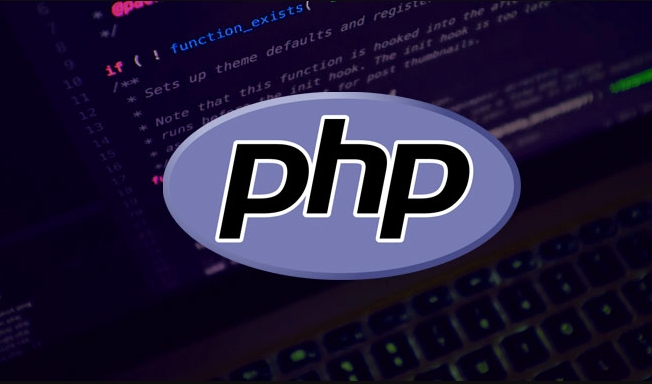 Backend Development
Backend Development
 PHP Tutorial
PHP Tutorial
 how to get the next value in a php array without advancing the pointer
how to get the next value in a php array without advancing the pointer
how to get the next value in a php array without advancing the pointer
Jul 04, 2025 am 02:48 AMGet the next value of the array in PHP without moving the internal pointer, which can be achieved by the following methods: 1. Use next() and prev() to temporarily move the pointer and restore it; 2. Use array_keys() to manually find the next element; 3. Encapsulate it as a helper function to improve reusability. These three methods are suitable for different scenarios, such as simple operation, avoiding pointer changes or requiring neat codes.

In PHP, if you want to get the next value in an array without moving the internal pointer forward, there's no direct built-in function that does exactly that. But with a few tricks, you can achieve it pretty easily.

1. Use current() and next() but reset the pointer
One common way is to use next() to peek at the next value, then immediately use prev() or reset() to move the pointer back. This approach works well for simple use cases:

$array = [10, 20, 30]; current($array); // Make sure pointer is at the beginning $nextValue = next($array); prev($array); // Or reset($array) if you want to go back to the start echo $nextValue; // Outputs: 20
This method temporarily advances the pointer just enough to read the next value, then restores it. It's straightforward but be cautious when using this in loops or complex logic where pointer position matters.
2. Use array_slice() to get the next element
If you don't want to touch the pointer at all, you can work directly with keys. Here's how to do it by getting the current key and accessing the next index manually:

$array = [10, 20, 30];
$keys = array_keys($array);
$currentIndex = key($array); // Or manually set if needed
if (($nextKey = array_search($currentIndex, $keys)) !== false && isset($keys[$nextKey 1])) {
$nextValue = $array[$keys[$nextKey 1]];
echo $nextValue; // Outputs: 20
}This avoids changing the pointer entirely and gives you more control over array traversal. Just keep in mind that it requires extra steps like extracting keys and searching through them.
3. Use a custom helper function
For cleaner code, especially if you're doing this often, wrap it in a reusable function:
function peek_next($array, $currentKey) {
$keys = array_keys($array);
$index = array_search($currentKey, $keys);
if ($index !== false && isset($keys[$index 1])) {
return $array[$keys[$index 1]];
}
return null;
}
// Usage
$array = [10, 20, 30];
$currentKey = key($array); // eg, '0'
echo peek_next($array, $currentKey); // Outputs: 20This method is safe and keeps your main logic clean. You pass in the array and the current key, and it returns the next value (or null if none exists).
- If you're OK with briefly moving the pointer,
next()prev()is quick and readable. - If you need to avoid touching the pointer altogether, working with keys via
array_keys()is safe. - For better reusability and clarity, a helper function makes sense.
Basically that's it.
The above is the detailed content of how to get the next value in a php array without advancing the pointer. For more information, please follow other related articles on the PHP Chinese website!

Hot AI Tools

Undress AI Tool
Undress images for free

Undresser.AI Undress
AI-powered app for creating realistic nude photos

AI Clothes Remover
Online AI tool for removing clothes from photos.

Clothoff.io
AI clothes remover

Video Face Swap
Swap faces in any video effortlessly with our completely free AI face swap tool!

Hot Article

Hot Tools

Notepad++7.3.1
Easy-to-use and free code editor

SublimeText3 Chinese version
Chinese version, very easy to use

Zend Studio 13.0.1
Powerful PHP integrated development environment

Dreamweaver CS6
Visual web development tools

SublimeText3 Mac version
God-level code editing software (SublimeText3)

Hot Topics
 How do I implement authentication and authorization in PHP?
Jun 20, 2025 am 01:03 AM
How do I implement authentication and authorization in PHP?
Jun 20, 2025 am 01:03 AM
TosecurelyhandleauthenticationandauthorizationinPHP,followthesesteps:1.Alwayshashpasswordswithpassword_hash()andverifyusingpassword_verify(),usepreparedstatementstopreventSQLinjection,andstoreuserdatain$_SESSIONafterlogin.2.Implementrole-basedaccessc
 How can you handle file uploads securely in PHP?
Jun 19, 2025 am 01:05 AM
How can you handle file uploads securely in PHP?
Jun 19, 2025 am 01:05 AM
To safely handle file uploads in PHP, the core is to verify file types, rename files, and restrict permissions. 1. Use finfo_file() to check the real MIME type, and only specific types such as image/jpeg are allowed; 2. Use uniqid() to generate random file names and store them in non-Web root directory; 3. Limit file size through php.ini and HTML forms, and set directory permissions to 0755; 4. Use ClamAV to scan malware to enhance security. These steps effectively prevent security vulnerabilities and ensure that the file upload process is safe and reliable.
 What are the differences between == (loose comparison) and === (strict comparison) in PHP?
Jun 19, 2025 am 01:07 AM
What are the differences between == (loose comparison) and === (strict comparison) in PHP?
Jun 19, 2025 am 01:07 AM
In PHP, the main difference between == and == is the strictness of type checking. ==Type conversion will be performed before comparison, for example, 5=="5" returns true, and ===Request that the value and type are the same before true will be returned, for example, 5==="5" returns false. In usage scenarios, === is more secure and should be used first, and == is only used when type conversion is required.
 How do I perform arithmetic operations in PHP ( , -, *, /, %)?
Jun 19, 2025 pm 05:13 PM
How do I perform arithmetic operations in PHP ( , -, *, /, %)?
Jun 19, 2025 pm 05:13 PM
The methods of using basic mathematical operations in PHP are as follows: 1. Addition signs support integers and floating-point numbers, and can also be used for variables. String numbers will be automatically converted but not recommended to dependencies; 2. Subtraction signs use - signs, variables are the same, and type conversion is also applicable; 3. Multiplication signs use * signs, which are suitable for numbers and similar strings; 4. Division uses / signs, which need to avoid dividing by zero, and note that the result may be floating-point numbers; 5. Taking the modulus signs can be used to judge odd and even numbers, and when processing negative numbers, the remainder signs are consistent with the dividend. The key to using these operators correctly is to ensure that the data types are clear and the boundary situation is handled well.
 How can you interact with NoSQL databases (e.g., MongoDB, Redis) from PHP?
Jun 19, 2025 am 01:07 AM
How can you interact with NoSQL databases (e.g., MongoDB, Redis) from PHP?
Jun 19, 2025 am 01:07 AM
Yes, PHP can interact with NoSQL databases like MongoDB and Redis through specific extensions or libraries. First, use the MongoDBPHP driver (installed through PECL or Composer) to create client instances and operate databases and collections, supporting insertion, query, aggregation and other operations; second, use the Predis library or phpredis extension to connect to Redis, perform key-value settings and acquisitions, and recommend phpredis for high-performance scenarios, while Predis is convenient for rapid deployment; both are suitable for production environments and are well-documented.
 How do I stay up-to-date with the latest PHP developments and best practices?
Jun 23, 2025 am 12:56 AM
How do I stay up-to-date with the latest PHP developments and best practices?
Jun 23, 2025 am 12:56 AM
TostaycurrentwithPHPdevelopmentsandbestpractices,followkeynewssourceslikePHP.netandPHPWeekly,engagewithcommunitiesonforumsandconferences,keeptoolingupdatedandgraduallyadoptnewfeatures,andreadorcontributetoopensourceprojects.First,followreliablesource
 What is PHP, and why is it used for web development?
Jun 23, 2025 am 12:55 AM
What is PHP, and why is it used for web development?
Jun 23, 2025 am 12:55 AM
PHPbecamepopularforwebdevelopmentduetoitseaseoflearning,seamlessintegrationwithHTML,widespreadhostingsupport,andalargeecosystemincludingframeworkslikeLaravelandCMSplatformslikeWordPress.Itexcelsinhandlingformsubmissions,managingusersessions,interacti
 How to set PHP time zone?
Jun 25, 2025 am 01:00 AM
How to set PHP time zone?
Jun 25, 2025 am 01:00 AM
TosettherighttimezoneinPHP,usedate_default_timezone_set()functionatthestartofyourscriptwithavalididentifiersuchas'America/New_York'.1.Usedate_default_timezone_set()beforeanydate/timefunctions.2.Alternatively,configurethephp.inifilebysettingdate.timez





